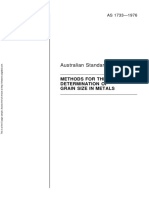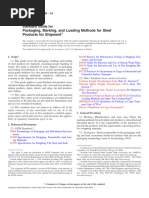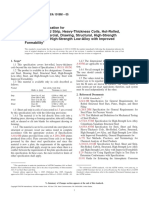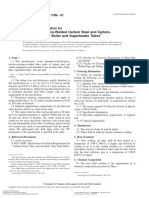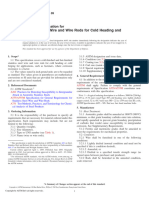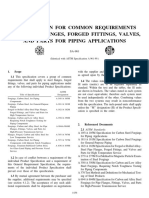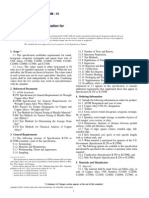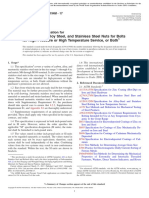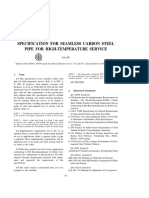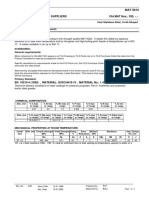011-Astm A 131 2008 Structural Steel For Ships PDF
011-Astm A 131 2008 Structural Steel For Ships PDF
Uploaded by
graduateCopyright:
Available Formats
011-Astm A 131 2008 Structural Steel For Ships PDF
011-Astm A 131 2008 Structural Steel For Ships PDF
Uploaded by
graduateOriginal Title
Copyright
Available Formats
Share this document
Did you find this document useful?
Is this content inappropriate?
Copyright:
Available Formats
011-Astm A 131 2008 Structural Steel For Ships PDF
011-Astm A 131 2008 Structural Steel For Ships PDF
Uploaded by
graduateCopyright:
Available Formats
Designation: A 131/A 131M – 08
Standard Specification for
Structural Steel for Ships1
This standard is issued under the fixed designation A 131/A 131M; the number immediately following the designation indicates the year
of original adoption or, in the case of revision, the year of last revision. A number in parentheses indicates the year of last reapproval.
A superscript epsilon (e) indicates an editorial change since the last revision or reapproval.
This standard has been approved for use by agencies of the Department of Defense.
1. Scope* A 6/A 6M Specification for General Requirements for
1.1 This specification covers structural steel plates, shapes, Rolled Structural Steel Bars, Plates, Shapes, and Sheet
bars, and rivets intended primarily for use in ship construction. Piling
1.2 Material under this specification is available in the A 370 Test Methods and Definitions for Mechanical Testing
following categories: of Steel Products
1.2.1 Ordinary Strength—Grades A, B, D, and E with a E 112 Test Methods for Determining Average Grain Size
specified minimum yield point of 34 ksi [235 MPa], and 3. Terminology
1.2.2 Higher Strength—Grades AH, DH, EH, and FH with
a specified minimum yield point of 46 ksi [315 MPa], 51 ksi 3.1 Definitions of Terms Specific to This Standard:
[350 MPa], or 57 ksi [390 MPa]. 3.1.1 control rolling, n—a steel treatment that consists of
1.3 Shapes and bars are normally available as Grades A, final rolling within the range used for normalizing heat
AH32, and AH36. Other grades may be furnished by agree- treatments so that the austenite completely recrystallizes.
ment between the purchaser and the manufacturer. 3.1.2 thermo-mechanical controlled processing, n—a steel
1.4 The maximum thickness of products furnished under treatment that consists of strict control of the steel temperature
this specification is 4 in. [100 mm] for plates and 2 in. [50 mm] and the rolling reduction. A high proportion of the rolling
for shapes and bars. reduction is to be carried out close to or below the Ar3
1.5 When the steel is to be welded, it is presupposed that a transformation temperature and may involve rolling towards
welding procedure suitable for the grade of steel and intended the lower end of the temperature range of the intercritical
use or service will be utilized. See Appendix X3 of Specifica- dual-phase region, thus permitting little if any recrystallization
tion A 6/A 6M for information on weldability. of the austenite. The process may involve accelerated cooling
1.6 The values stated in either inch-pound units or SI units on completion of rolling.
are to be regarded separately as the standard. Within the text, 4. Ordering Information
the SI units are shown in brackets. The values stated in each
system are not exact equivalents; therefore, each system must 4.1 Specification A 6/A 6M establishes the rules for the
be used independently of the other. Combining values from the ordering information that should be complied with when
two systems may result in nonconformance with this specifi- purchasing material to this specification.
cation. 4.2 Additional ordering considerations specific to this speci-
fication are:
2. Referenced Documents 4.2.1 Condition (control rolled or thermo-mechanical con-
2.1 ASTM Standards: 2 trol processed, if applicable).
5. Materials and Manufacture
1
This specification is under the jurisdiction of ASTM Committee A01 on Steel, 5.1 Rimmed steels shall not be applied.
Stainless Steel and Related Alloys and is the direct responsibility of Subcommittee 5.2 Except for Grades A and B steel, semi-killed steels shall
A01.02 on Structural Steel for Bridges, Buildings, Rolling Stock and Ships.
Current edition approved March 1, 2008. Published March 2008. Originally
not be applied.
approved in 1931. Last previous edition approved in 2007 as A 131/A 131M – 07. 5.3 Grades D, E, AH32, AH36, AH40, DH32, DH36, DH40,
2
For referenced ASTM standards, visit the ASTM website, www.astm.org, or EH32, EH36, EH40, FH32, FH36, and FH40 shall be made
contact ASTM Customer Service at service@astm.org. For Annual Book of ASTM using a fine grain practice. For ordinary-strength grades,
Standards volume information, refer to the standard’s Document Summary page on
the ASTM website. aluminum shall be used to obtain grain refinement. For
*A Summary of Changes section appears at the end of this standard.
Copyright © ASTM International, 100 Barr Harbor Drive, PO Box C700, West Conshohocken, PA 19428-2959, United States.
1
--`,`,`,,`,,```````
Copyright ASTM International
Provided by IHS under license with ASTM Licensee=Simon Carves Limited/5921537001
No reproduction or networking permitted without license from IHS Not for Resale, 07/22/2008 00:56:46 MDT
A 131/A 131M – 08
higher-strength grades, aluminum, vanadium, or columbium 7.2.2 When vanadium and aluminum are used in combi-
(niobium) may be used for grain refinement. nation, minimum vanadium content of 0.030 % and minimum
5.4 Plates in all thicknesses ordered to Grade E shall be acid-soluble aluminum content of 0.010 %, or minimum total
normalized, or thermo-mechanical control processed. Plates aluminum content of 0.015 %.
over 13⁄8 in. [35 mm] in thickness ordered to Grade D shall be 7.2.3 When columbium (niobium) and aluminum are used
normalized, control rolled, or thermo-mechanical control pro- in combination, minimum columbium (niobium) content of
cessed. See Table 1. 0.010 % and minimum acid-soluble aluminum content of
5.5 Plates in all thicknesses ordered to Grades EH32 and 0.010 %, or minimum total aluminum content of 0.015 %.
EH36 shall be normalized, or thermo-mechanical control 7.2.4 A McQuaid-Ehn austenitic grain size of 5 or finer in
processed. Plates in all thicknesses ordered to Grade EH40, accordance with Test Methods E 112 for each ladle of each
FH32, FH36, and FH40 shall be normalized, thermo- heat.
mechanical control processed, or quenched and tempered.
Plates ordered to Grades AH32, AH36, AH40, DH32, DH36,
8. Mechanical Requirements
and DH40 shall be normalized, control rolled, thermo-
mechanical control processed, or quenched and tempered when 8.1 Tension Test:
so specified. See Table 2. 8.1.1 Except as specified in the following paragraphs, the
5.6 In the case of shapes, the thicknesses referred to are material as represented by the test specimens shall conform to
those of the flange. Heat treatment and rolling requirements for the tensile requirements prescribed in Table 6.
shapes and bars are given in Table 1 and Table 2. 8.1.1.1 Shapes less than 1 in.2 [645 mm2] in cross section,
6. Chemical Requirements and bars, other than flats, less than 1⁄2 in. [12.5 mm] in
thickness or diameter need not be subjected to tension tests by
6.1 The heat analysis shall conform to the requirements for the manufacturer, but chemistry consistent with the required
chemical composition given in Table 3 and Table 4. tensile properties must be applied.
6.1.1 When specified, the steel shall conform on product
analysis to the requirements given in Table 3 and Table 4, 8.1.1.2 The elongation requirement of Table 6 does not
subject to the product analysis tolerances in Specification apply to floor plates with a raised pattern. However, for floor
A 6/A 6M. plates over 1⁄2 in. [12.5 mm] in thickness, test specimens shall
6.2 For thermo-mechanical control process steel, the carbon be bent cold with the raised pattern on the inside of the
equivalent shall be determined from the heat analysis and shall specimen through an angle of 180° without cracking when
conform to the requirements given in Table 5. subjected to a bend test in which the inside diameter is three
times plate thickness. Sampling for bend testing shall be as
7. Metallurgical Structure specified for the tension tests in 8.1.2.
7.1 The steel grades indicated in 5.3 shall be made to fine 8.1.2 One tension test shall be made from each of two
grain practice, and the requirements for fine austenitic grain different plates, shapes, or bars from each heat of structural
size in Specification A 6/A 6M shall be met. steel unless the finished product from a heat is less than 50 tons
7.2 Where the use of fine grain practice using columbium, [45 Mg], in which case one tension test is sufficient. If,
vanadium, or combinations is permitted in 5.3, one or more of however, product from one heat differs 3⁄8 in. [10 mm] or more
the following shall be met: in thickness or diameter, one tension test shall be made from
7.2.1 Minimum columbium (niobium) content of 0.020 % both the thickest and the thinnest structural product rolled,
or minimum vanadium content of 0.050 % for each heat, or regardless of the weight [mass] represented.
TABLE 1 Condition of Supply and Frequency of Impact Tests for Ordinary-Strength Structural Steel
Condition of SupplyB (Frequency of Impact TestC )
A Thickness (t ), in. [mm]
Grade Deoxidation Product
t >0.25 [6.4] t >1.0 [25] t >1.375 [35] t >2.0 [50]
t #1.0 [25] t #1.375 [35] t #2.0 [50] t #4.0 [100]
Semi-Killed All NAD
N (–)E, TM (–), CR (50 [45]),
A P A (– )
Killed AR (50 [45])
S NAD
D
Semi-Killed All NA
N (50 [45]), TM (50 [45]),
B P A (–) A (50 [45])
Killed CR (25 [23]), AR (25 [23])
S NAD
N (50 [45]), N (50 [45]), TM (50 [45]),
Killed, Fine Grain P
D A (50 [45]), N (50 [45]) TM (50 [45]), CR (25 [23])
Practice
S CR (50 [45]) NAD
Killed, Fine Grain P N (P), TM (P) N (P), TM (P)
E
Practice S N (25 [23]), TM (25 [23]), CR (15 [14]) NAD
A
Product: P = plate; S = shapes and bars
B
Condition of Supply: A = any condition; AR = as-rolled; N = normalized; CR = control rolled; TM = thermo-mechanical controlled processing
C
Frequency of Impact Test: (impact test lot size in tons [Mg] from each heat); (–) = no impact test required; (P) = each plate-as-rolled
D
Condition of supply is not applicable
E
Impact tests for Grade A are not required if material is produced using a fine grain practice and normalized
--`,`,`,,`,,`````````,,,`,``,,,`-`-`,,`,,`,`,,`---
Copyright ASTM International 2
Provided by IHS under license with ASTM Licensee=Simon Carves Limited/5921537001
No reproduction or networking permitted without license from IHS Not for Resale, 07/22/2008 00:56:46 MDT
A 131/A 131M – 08
TABLE 2 Condition of Supply and Frequency of Impact Tests for Higher-Strength Structural Steel
Condition of SupplyB (Frequency of Impact TestC )
Thickness (t ), in. [mm]
Grain
Grade Deoxidation Refining ProductA t >0.5
Element t >0.25 [6.4] [12.5] t >0.80 [20] t >1.0 [25] t >1.375 [35] t >2.0 [50]
t #0.5 [12.5] t #0.80 t #1.0 [25] t #1.375 [35] t #2.0 [50] t #4.0 [100]
[20]
N (50 [45]), TM (50
Cb P A (50 [45]) N (50 [45]), TM (50 [45]), CR (50 [45])
[45]), CR (25 [23])
V
S A (50 [45]) N (50 [45]), TM (50 [45]), CR (50 [45]), AR (25 [23]) NAD
AR (25 [23]), N
(50 [45]) , TM N (50 [45]), TM (50 [45]), N (50 [45],) TM (50
AH32 Al P A (50 [45])
(50 [45]), CR (50 CR (50 [45]) [45]), CR (25 [23])
AH36
[45])
AR (25 [23]), N N (50 [45]), TM (50 [45]), CR (50 NAD
(50 [45]), TM (50 [45]), AR (25 [23])
Al + Ti S A (50 [45])
[45]), CR (50
Killed, Fine [45])
Grain N (50 [45]), TM (50
Cb P A (50 [45]) N (50 [45]), TM (50 [45]), CR (50 [45])
Practice [45]), CR (25 [23])
V S A (50 [45]) N (50 [45]), TM (50 [45]), CR (50 [45]) NAD
AR (25 [23]), N
(50 [45]), TM (50 N (50 [45]), TM (50 [45]), N (50 [45]), TM (50
DH32 Al P A (50 [45])
[45]), CR (50 CR (50 [45]) [45]), CR (25 [23])
DH36
[45])
AR (25 [23]), N NAD
(50 [45]), TM (50 N (50 [45]), TM (50 [45]),
Al + Ti S A (50 [45])
[45]), CR (50 CR (50 [45])
[45])
EH32 P N (P), TM (P) N (P), TM (P)
Any
EH36 S N (25 [23]), TM (25 [23]), CR (15 [14]) NAD
FH32 P N (P), TM (P), QT (P) N (P), TM (P), QT
Any
FH36 S N (25 [23]), TM (25 [23]), QT (25 [23]) NAD
--`,`,`,,`,,`````````,,,`,``,,,`-`-`,,`,,`,`,,`---
N (50 [45]), TM (50
P A (50 [45]) N (50 [45]), TM (50 [45]), CR (50 [45])
AH40 Any [45]), QT (P)
S A (50 [45]) N (50 [45]), TM (50 [45]), CR (50 [45]) NAD
P N (50 [45]), TM (50 [45]), CR (50 [45]) N (50 [45]), TM (50
DH40 Any [45]), QT (P)
S N (50 [45]), TM (50 [45]), CR (50 [45]) NAD
P N (P), TM (P),
N (P), TM (P), QT (P)
EH40 Any QT (P)
S N (25 [23]), TM (25 [23]), CR (25 [23]) NAD
P N (P), TM (P),
N (P), TM (P), QQT (P)
FH40 Any QT (P)
S N (25 [23]), TM (25), CR (25 [23]) NAD
A
Product: P = plate; S = shapes and bars
B
Condition of Supply: A = any condition; AR = as-rolled; TM = thermo-mechanical controlled processing; CR = control rolled; QT = quenched and tempered; N =
normalized
C
Frequency of Impact Test: (impact test lot size in tons [Mg] from each heat); (P) = each plate-as-rolled
D
Condition of supply is not applicable
8.1.3 For quenched and tempered steel, including Grades made from the thickest material in each test lot size of each
EH40, FH32, FH36, and FH40, one tension test shall be made heat, as required by Table 1 and Table 2. If heat testing is
on each plate as quenched and tempered. required, a set of three specimens shall be tested for each test
8.2 Toughness Tests: lot size indicated in Table 1 and Table 2, of the same type of
8.2.1 Charpy V-notch tests shall be made on Grade A product produced on the same mill from each heat of steel. The
material over 2 in. [50 mm] in thickness, on Grade B material set of impact specimens shall be taken from different as-rolled
over 1 in. [25 mm] in thickness and on material over 1⁄4 in. [6.4 or heat-treated pieces of the heaviest gage produced. An
mm] in thickness of Grades D, E, AH32, AH36, AH40, DH32, as-rolled piece refers to the product rolled from a slab, billet,
DH36, DH40, EH32, EH36, EH40, FH32, FH36, and FH40, as bloom, or directly from an ingot. Where the maximum thick-
required by Table 1 and Table 2. The frequency of Charpy ness or diameter of various sections differs by 3⁄8 in. [10 mm]
V-notch impact tests shall be as given in Table 1 and Table 2. or more, one set of impacts shall be made from both the
The test results shall conform to the requirements given in thickest and the thinnest material rolled regardless of the
Table 7. weight represented.
8.2.2 For Grades EH32, EH36, EH40, FH32, FH36, and 8.2.4 The specimens for plates shall be taken from a corner
FH40 plate material, one set of three impact specimens shall be of the material and the specimens from shapes shall be taken
made from each plate-as-rolled. from the end of a shape at a point one third the distance from
8.2.3 For Grade A, B, D, AH32, AH36, AH40, DH32, the outer edge of the flange or leg to the web or heel of the
DH36, and DH40 plate material, and for all shape material, and shape. Specimens for bars shall be in accordance with Speci-
all bar material, one set of three impact specimens shall be fication A 6/A 6M.
Copyright ASTM International 3
Provided by IHS under license with ASTM Licensee=Simon Carves Limited/5921537001
No reproduction or networking permitted without license from IHS Not for Resale, 07/22/2008 00:56:46 MDT
A 131/A 131M – 08
TABLE 3 Chemical Requirements for Ordinary-Strength Structural Steel
Chemical Composition (heat analysis), % max unless otherwise specifiedA
Grade A Grade B Grade D Grade E
Deoxidation and Thickness (t ), in. [mm]
Element
Killed or Semi-Killed Killed or Semi-Killed
t #2.0 in. [50 mm] t #2.0 in. [50 mm] Killed, Fine Killed, Fine
Killed Killed Grain PracticeB Grain PracticeB
t >2.0 in. [50 mm] t >2.0 in. [50 mm]
C 0.21C 0.21 0.21 0.18
Mn, min 2.5 3 C 0.60 0.60 0.70
Si 0.50 0.35 0.10–0.35D 0.10–0.35D
P 0.035 0.035 0.035 0.035
S 0.035 0.035 0.035 0.035
E E E E
Ni
E E E E
Cr
E E E E
Mo
E E E E
Cu
C + Mn/6 0.40 0.40 0.40 0.40
A
Intentionally added elements are to be determined and reported.
B
Grade D steel over 1.0 in. [25 mm] and Grade E steel are to contain at least one of the grain refining elements in sufficient amount to meet the fine grain practice
requirements (see Section 7).
C
A maximum carbon content of 0.23 % is acceptable for Grade A shapes and bars.
D
Where the content of acid soluble aluminum is not less than 0.015 %, the minimum required silicon content does not apply.
E
The contents of nickel, chromium, molybdenum, and copper are to be determined and reported. When the amount does not exceed 0.02 %, these elements may be
reported as #0.02 %.
TABLE 4 Chemical Requirements for Higher-Strength Structural Steel
Chemical CompositionA (heat analysis), % max unless otherwise specified
Grades AH/DH/EH32, AH/DH/EH36,
Grades FH32/36/40
Element and AH/DH/EH40
Deoxidation
Killed, Fine Grain PracticeB Killed, Fine Grain PracticeB
C 0.18 0.16
Mn 0.90–1.60C 0.90–1.60
Si 0.10–0.50D 0.10–0.50D
P 0.035 0.025
S 0.035 0.025
Al (acid soluble), minE,F 0.015 0.015
CbF 0.02–0.05 0.02–0.05
VF 0.05–0.10 0.05–0.10
Ti 0.02 0.02
Cu 0.35 0.35
Cr 0.20 0.20
Ni 0.40 0.40
Mo 0.08 0.08
N ... 0.009G
A
The contents of any other element intentionally added is to be determined and reported.
B
The steel is to contain at least one of the grain refining elements in sufficient amount to meet the fine grain practice requirement (see Section 7).
C
Grade AH 0.5 in. [12.5 mm] and under in thickness may have a minimum manganese content of 0.70 %.
D
If the content of soluble aluminum is not less than 0.015 %, the minimum required silicon content does not apply.
E
The total aluminum content may be used instead of acid soluble content, in accordance with 7.1.
F
The indicated amount of aluminum, columbium, and vanadium applies if any such element is used singly. If used in combination, the minimum content in 7.2.2 and
7.2.3, as appropriate, will apply.
G
0.012 if aluminum is present.
8.2.5 The largest size specimens possible for the material parallel or transverse to the final direction of rolling of the
thickness are to be machined. The longitudinal axis of each structural product at the option of the steel manufacturer.
specimen shall be located midway between the surface and the 8.2.7 The impact test shall be made in accordance with the
center of the structural product thickness, and the length of the Charpy Impact Testing section in Test Methods and Definitions
--`,`,`,,`,,`````````,,,`,``,,,`-`-`,,`,,`,`,,`---
notch shall be perpendicular to the rolled surface of the A 370.
structural product. 8.2.8 Each impact test shall constitute the average value of
8.2.6 Unless a specific orientation is called for on the three specimens taken from a single test location. The average
purchase order, the longitudinal axis of the specimens may be value shall meet the specified minimum average with not more
Copyright ASTM International 4
Provided by IHS under license with ASTM Licensee=Simon Carves Limited/5921537001
No reproduction or networking permitted without license from IHS Not for Resale, 07/22/2008 00:56:46 MDT
A 131/A 131M – 08
TABLE 5 Carbon Equivalent for Higher-Strength Structural Steel the results of its own test. It shall also be the option of the
Produced by TMCP producer to heat treat the product prior to retesting if desired.
Carbon EquivalentA, max, %
9. General Requirements for Delivery
Thickness (t ), in. [mm]
Grade
t >2.0 in. [50 mm]
9.1 Material furnished under this specification shall con-
t #2.0 in. [50 mm]
t #4.0 in. [100 mm] form to the requirements of the current edition of Specification
AH32, DH32, EH32, FH32 0.36 0.38 A 6/A 6M, for the specific structural product ordered, unless a
AH36, DH36, EH36, FH36 0.38 0.40 conflict exists in which case this specification shall prevail.
AH40, DH40, EH40, FH40 0.40 0.42
A
The following carbon equivalent formula shall be used to calculate the carbon 10. Plate Conditioning
equivalent, Ceq: 10.1 After removal of any imperfection preparatory to
Mn Cr 1 Mo 1 V Ni 1 Cu
Ceq 5 C 1
6
1
5
1
15 ~%! welding the thickness of the plate at any location must not be
reduced by more than 20 % of the nominal thickness of the
plate.
than one value below the specified minimum average but in no 11. Test Reports
case below 70 % of the specified minimum average.
11.1 When test reports are required by the purchase order,
8.2.8.1 If the results fail to meet the preceding requirements
the report shall show the results of each test required by
but 8.2.8.1 (2) and (3) are complied with, three additional
Sections 7 and 8, except that the results of only one set of tests
specimens may be taken from the location as close to the initial
need be reported when the amount of material from a heat in a
specimens as possible and their test results added to those
shipment is less than 10 tons [9 Mg] and when the thickness
previously obtained to form a new average. The structural
variations described in Section 8 are not exceeded.
product represented may be accepted if for the six specimens
11.2 The thickness of the product tested may not necessarily
8.2.8.1 (1), (2), and (3) are met.
be the same as an individual ordered thickness since it is the
(1) The average is not less than the required minimum
heat that is tested rather than each ordered item.
average.
(2) No more than two individual values are below the 12. Marking
required minimum average. 12.1 Plates produced to a normalized heat treatment condi-
(3) No more than one individual value is below 70 % of the tion shall be marked with the suffix N to indicate that the plates
required minimum average. have been normalized.
8.2.8.2 If the required energy values are not obtained upon 12.2 Plates produced to a control rolled condition shall be
retest, the material may be heat treated at the option of the marked with the suffix CR to indicate that the plates have been
producer in the case of as-rolled material or reheat treated in control rolled.
the case of heat-treated material. 12.3 Plates produced to a thermo-mechanical control pro-
8.2.8.3 After heat treatment or reheat treatment, a set of cessed condition shall be marked with the suffix TM to indicate
three specimens shall be tested and evaluated in the same that the plates have been thermo-mechanical control processed.
manner as for the original material. 12.4 Plates produced to a quenched and tempered heat
8.2.8.4 If the impact test result fails to meet the requirement treatment condition shall be marked with the suffix QT to
for the thickest product tested when heat testing, that material indicate that the plates have been quenched and tempered.
shall be rejected and the next thickest material may be tested to
qualify the balance of the heat in accordance with 8.2.8. At the 13. Keywords
option of the producer, retests may be made on each piece of 13.1 bars; higher strength; ordinary strength; plates; rivets;
the rejected material, in which case each piece shall stand on shapes; ship construction; steel; structural steel
--`,`,`,,`,,`````````,,,`,``,,,`-`-`,,`,,`,`,,`---
Copyright ASTM International 5
Provided by IHS under license with ASTM Licensee=Simon Carves Limited/5921537001
No reproduction or networking permitted without license from IHS Not for Resale, 07/22/2008 00:56:46 MDT
A 131/A 131M – 08
TABLE 6 Tensile Requirements for Ordinary-Strength and Higher-Strength Structural Steel
Tensile Strength, Yield Point, min, Elongation in 8 in. [200 mm]A,B, Elongation in 2 in. [50 mm]B,C,
Grade
ksi [MPa] ksi [MPa] min, % min %
Ordinary strength:
A, B, D, E 58 to 75 [400 to 520]D 34 [235] 21 24
Higher strength:
AH32, DH32, EH32, FH32 64 to 85 [440 to 590] 46 [315] 19 22
AH36, DH36, EH36, FH36 71 to 90 [490 to 620] 51 [355] 19 22
AH40, DH40, EH40, FH40 74 to 94 [510 to 650] 57 [390] 19 22
A
For nominal thickness or diameter under 5⁄16 in. [8 mm], a deduction from the specified percentage of elongation in 8 in. [200 mm] shall be made. See elongation
requirement adjustments under the Tension Tests section of Specification A 6/A 6M for deduction values.
B
Elongation is not required for floor plate.
C
For nominal thickness or diameter over 3.5 in. [90 mm], a deduction from the specified percentage of elongation in 2 in. [50 mm] shall be made. See elongation
requirement adjustments under the Tension Tests section of Specification A 6/A 6M for deduction values.
D
For Grade A shapes and bars, the upper limit of tensile strength may be 80 ksi [550 MPa].
TABLE 7 Charpy V-Notch Impact Requirements for Ordinary-Strength and Higher-Strength Structural Steel
Average Absorbed EnergyC, min, ft·lbf [J]
Thickness (t ), in. [mm]
A,B Test Temperature, t >2.0 in. [50 mm] t >2.8 in. [70 mm]
Grade t #2.0 in. [50 mm]
°F [°C] t #2.8 in. [70 mm] t #4.0 in. [100 mm]
Charpy V-notch Impact Specimen OrientationD
Longitudinal Transverse Longitudinal Transverse Longitudinal Transverse
AE 68 [20] ... ... 25 [34] 17 [24] 30 [41] 20 [27]
B 32 [0] 20 [27] 14 [20] 25 [34] 17 [24] 30 [41] 20 [27]
AH32 32 [0] 23 [31] 16 [22] 28 [38] 19 [26] 34 [46] 23 [31]
--`,`,`,,`,,`````````,,,`,``,,,`-`-`,,`,,`,`,,`---
AH36 32 [0] 25 [34] 17 [24] 30 [41] 20 [27] 37 [50] 25 [34]
AH40 32 [0] 29 [39] 19 [26] 34 [46] 23 [31] 41 [55] 27 [37]
D –4 [–20] 20 [27] 14 [20] 25 [34] 17 [24] 30 [41] 20 [27]
DH32 –4 [–20] 23 [31] 16 [22] 28 [38] 19 [26] 34 [46] 23 [31]
DH36 –4 [–20] 25 [34] 17 [24] 30 [41] 20 [27] 37 [50] 25 [34]
DH40 –4 [–20] 29 [39] 19 [26] 34 [46] 23 [31] 41 [55] 27 [37]
E –40 [–40] 20 [27] 14 [20] 25 [34] 17 [24] 30 [41] 20 [27]
EH32 –40 [–40] 23 [31] 16 [22] 28 [38] 19 [26] 34 [46] 23 [31]
EH36 –40 [–40] 25 [34] 17 [24] 30 [41] 20 [27] 37 [50] 25 [34]
EH40 –40 [–40] 29 [39] 19 [26] 34 [46] 23 [31] 41 [55] 27 [37]
FH32 –76 [–60] 23 [31] 16 [22] 28 [38] 19 [26] 34 [46] 23 [31]
FH36 –76 [–60] 25 [34] 17 [24] 30 [41] 20 [27] 37 [50] 25 [34]
FH40 –76 [–60] 29 [39] 19 [26] 34 [46] 23 [31] 41 [55] 27 [37]
A
Charpy V-notch impact test requirements for ordinary-strength structural steel grades apply where such test is required by Table 1.
B
Charpy V-notch impact test requirements for higher-strength structural steel grades apply where such test is required by Table 2.
C
The energy shown is minimum for full-sized (0.394 by 0.394-in. [10 3 10-mm]) specimen. For sub-sized specimens, the energy shall be as follows:
Specimen Size, in. [mm] 0.394 3 0.295 [10 3 7.5] 0.394 3 0.197 [10 3 5.0] 0.394 3 0.098 [10 3 2.5]
Required Energy 5E/6 2E/3 E/2
E—energy required for full-sized specimen
D
Either direction is acceptable.
E
Impact tests for Grade A are not required when the material is produced using fine grain practice and normalized.
SUPPLEMENTARY REQUIREMENTS
The following supplementary requirements shall apply only when specified in the order:
S32. Single Heat Bundles S87. Heat-Treatment of Grade DH
S32.1 Bundles containing shapes or bars shall be from a S87.1 Grade DH aluminum-treated steel over 3⁄4 in. [19
single heat of steel. mm] in thickness shall be normalized.
S85. Product Chemical Analysis
S85.1 The chemical composition shall be determined for S88. Additional Tension Tests
plates, shapes, or bars in accordance with 6.1.1. The number of S88.1 At least one tension test shall be made from each 50
pieces to be tested shall be stated on the order. tons [45 Mg] or fraction thereof from each heat. If the material
S86. Orientation of Impact Specimens differs by 0.375 in. [10 mm] or more in nominal thickness or
diameter, one tension test shall be made from both the thickest
S86.1 The orientation of the impact test specimens shall be
as specifically stated on the order. (The purchaser shall state and thinnest material in each 50 tons.
whether the tests are to be longitudinal or transverse.)
Copyright ASTM International 6
Provided by IHS under license with ASTM Licensee=Simon Carves Limited/5921537001
No reproduction or networking permitted without license from IHS Not for Resale, 07/22/2008 00:56:46 MDT
A 131/A 131M – 08
SUMMARY OF CHANGES
Committee A01 has identified the location of selected changes to this standard since the last issue
(A 131/A 131M – 07) that may impact the use of this standard. (Approved March 1, 2008.)
(1) Added 1.4 and renumbered 1.5 and 1.6. (3) Revised Table 1, Table 2, Table 3, Table 6, and Table 7.
(2) Revised 5.5. (4) Deleted all references to Grade CS throughout.
Committee A01 has identified the location of selected changes to this standard since the last issue
(A 131/A 131M – 04e1) that may impact the use of this standard. (Approved March 1, 2007.)
(1) Revised 5.3. (3) Revised Table 1, Table 2, Table 3, Table 5, and Table 7.
(2) Deleted paragraph 5.3.1.
ASTM International takes no position respecting the validity of any patent rights asserted in connection with any item mentioned
in this standard. Users of this standard are expressly advised that determination of the validity of any such patent rights, and the risk
of infringement of such rights, are entirely their own responsibility.
This standard is subject to revision at any time by the responsible technical committee and must be reviewed every five years and
if not revised, either reapproved or withdrawn. Your comments are invited either for revision of this standard or for additional standards
and should be addressed to ASTM International Headquarters. Your comments will receive careful consideration at a meeting of the
responsible technical committee, which you may attend. If you feel that your comments have not received a fair hearing you should
make your views known to the ASTM Committee on Standards, at the address shown below.
This standard is copyrighted by ASTM International, 100 Barr Harbor Drive, PO Box C700, West Conshohocken, PA 19428-2959,
United States. Individual reprints (single or multiple copies) of this standard may be obtained by contacting ASTM at the above
address or at 610-832-9585 (phone), 610-832-9555 (fax), or service@astm.org (e-mail); or through the ASTM website
(www.astm.org).
--`,`,`,,`,,`````````,,,`,``,,,`-`-`,,`,,`,`,,`---
Copyright ASTM International 7
Provided by IHS under license with ASTM Licensee=Simon Carves Limited/5921537001
No reproduction or networking permitted without license from IHS Not for Resale, 07/22/2008 00:56:46 MDT
You might also like
- Sugar Water: Physical Science and Unifying Themes Assessment ProbesNo ratings yetSugar Water: Physical Science and Unifying Themes Assessment Probes6 pages
- ASTM-A449: Licensed by Information Handling Services Licensed by Information Handling ServicesNo ratings yetASTM-A449: Licensed by Information Handling Services Licensed by Information Handling Services7 pages
- Momentum and Simple 1D Collisions Phet Lab: M M V V P V '0% (1)Momentum and Simple 1D Collisions Phet Lab: M M V V P V '2 pages
- As 1733-1976 Methods For The Determination of Grain Size in MetalsNo ratings yetAs 1733-1976 Methods For The Determination of Grain Size in Metals6 pages
- Packaging, Marking, and Loading Methods For Steel Products For ShipmentNo ratings yetPackaging, Marking, and Loading Methods For Steel Products For Shipment5 pages
- ASTM F3125 F3125M-19 Minimum Tensile StrengthNo ratings yetASTM F3125 F3125M-19 Minimum Tensile Strength13 pages
- UNS N08020, UNS N08024, and UNS N08026 Nickel Alloy Bar and WireNo ratings yetUNS N08020, UNS N08024, and UNS N08026 Nickel Alloy Bar and Wire6 pages
- Seamless and Welded Ferritic and Martensitic Stainless Steel Tubing For General ServiceNo ratings yetSeamless and Welded Ferritic and Martensitic Stainless Steel Tubing For General Service7 pages
- Determining The Susceptibility To Intergranular Corrosion of 5XXX Series Aluminum Alloys by Mass Loss After Exposure To Nitric Acid (NAMLT Test)No ratings yetDetermining The Susceptibility To Intergranular Corrosion of 5XXX Series Aluminum Alloys by Mass Loss After Exposure To Nitric Acid (NAMLT Test)3 pages
- ASTM E3024E3024M_22a_3_04_Standard_Practice_for_Magnetic_Particle_TestingNo ratings yetASTM E3024E3024M_22a_3_04_Standard_Practice_for_Magnetic_Particle_Testing20 pages
- Refined Lead: Standard Specification ForNo ratings yetRefined Lead: Standard Specification For4 pages
- Copper and Copper Alloy Forging Rod, Bar, and Shapes: Standard Specification ForNo ratings yetCopper and Copper Alloy Forging Rod, Bar, and Shapes: Standard Specification For8 pages
- Machining of Stainless Steels and Super Alloys: Traditional and Nontraditional TechniquesFrom EverandMachining of Stainless Steels and Super Alloys: Traditional and Nontraditional TechniquesNo ratings yet
- MCGB - Data Sheet For Suppliers Old MAT Nos.: 344, - , - : Heat-Resistant Cast Steel, Cr-Ni-AlloyedNo ratings yetMCGB - Data Sheet For Suppliers Old MAT Nos.: 344, - , - : Heat-Resistant Cast Steel, Cr-Ni-Alloyed3 pages
- MCGB - Data Sheet For Suppliers Old MAT Nos.: 343, - , - : Heat-Resistant Cast Steel, Cr-Ni-Alloyed100% (1)MCGB - Data Sheet For Suppliers Old MAT Nos.: 343, - , - : Heat-Resistant Cast Steel, Cr-Ni-Alloyed3 pages
- MCGB - Data Sheet For Suppliers Old MAT Nos.: 351, - , - : Cast Stainless Steel, Cr-Ni-AlloyedNo ratings yetMCGB - Data Sheet For Suppliers Old MAT Nos.: 351, - , - : Cast Stainless Steel, Cr-Ni-Alloyed3 pages
- MCGB - Data Sheet For Suppliers Old MAT Nos.: 350, - , - : Cast Stainless Steel, Cr-Ni-AlloyedNo ratings yetMCGB - Data Sheet For Suppliers Old MAT Nos.: 350, - , - : Cast Stainless Steel, Cr-Ni-Alloyed3 pages
- 215-Astm A 394 2000 Steel Transmission Tower Bolt, Zinc Coated - Bare PDFNo ratings yet215-Astm A 394 2000 Steel Transmission Tower Bolt, Zinc Coated - Bare PDF7 pages
- 213-Astm A 388 2001 Ultrasonic Examination of Heavy Steel Forgings PDF100% (1)213-Astm A 388 2001 Ultrasonic Examination of Heavy Steel Forgings PDF7 pages
- 003-Astm A 105 M 1998 Carbon Steel Forgings For Piping Applications PDFNo ratings yet003-Astm A 105 M 1998 Carbon Steel Forgings For Piping Applications PDF3 pages
- 012-ASTM A 134 1996 Pipe, Steel, Electric-Fusion (Arc) - Welded (Sizes NPS 16 - Over) PDFNo ratings yet012-ASTM A 134 1996 Pipe, Steel, Electric-Fusion (Arc) - Welded (Sizes NPS 16 - Over) PDF4 pages
- 214-Astm A 392 1996 Zinc Coated Steel Chain Link Fence Fabric PDFNo ratings yet214-Astm A 392 1996 Zinc Coated Steel Chain Link Fence Fabric PDF4 pages
- To Observe Refraction and Lateral Deviation of A Beam of Light Incident Obliquely On A Glass SlabNo ratings yetTo Observe Refraction and Lateral Deviation of A Beam of Light Incident Obliquely On A Glass Slab3 pages
- APSC 111 Midterm #1 2018 Question BookletNo ratings yetAPSC 111 Midterm #1 2018 Question Booklet9 pages
- CBSE Test Paper 01 Chapter 9 Differential EquationsNo ratings yetCBSE Test Paper 01 Chapter 9 Differential Equations7 pages
- Testing Procedure For The Single Fiber Fragmentation Test: Risø-R-1483 (EN)No ratings yetTesting Procedure For The Single Fiber Fragmentation Test: Risø-R-1483 (EN)30 pages
- Lesson Plan For Viii (Math B) 25TH June, 2024No ratings yetLesson Plan For Viii (Math B) 25TH June, 202410 pages
- DOC6 - Three-Phase Directional Overcurrent Protection Low-Set Stage (DOC6Low) High-Set Stage (DOC6High) Instantaneous Stage (DOC6Inst)No ratings yetDOC6 - Three-Phase Directional Overcurrent Protection Low-Set Stage (DOC6Low) High-Set Stage (DOC6High) Instantaneous Stage (DOC6Inst)35 pages
- SI 4222 Topik Khusus Geoteknik: Pertemuan Ke - 11 Site Response AnalysisNo ratings yetSI 4222 Topik Khusus Geoteknik: Pertemuan Ke - 11 Site Response Analysis90 pages
- 1St Year Course Code Descriptive Title Lec Units Lab Units Total Units Pre / Co RequisiteNo ratings yet1St Year Course Code Descriptive Title Lec Units Lab Units Total Units Pre / Co Requisite3 pages
- grade 9 and 10 physics formulae and unitsNo ratings yetgrade 9 and 10 physics formulae and units14 pages
- Sugar Water: Physical Science and Unifying Themes Assessment ProbesSugar Water: Physical Science and Unifying Themes Assessment Probes
- ASTM-A449: Licensed by Information Handling Services Licensed by Information Handling ServicesASTM-A449: Licensed by Information Handling Services Licensed by Information Handling Services
- Momentum and Simple 1D Collisions Phet Lab: M M V V P V 'Momentum and Simple 1D Collisions Phet Lab: M M V V P V '
- As 1733-1976 Methods For The Determination of Grain Size in MetalsAs 1733-1976 Methods For The Determination of Grain Size in Metals
- Packaging, Marking, and Loading Methods For Steel Products For ShipmentPackaging, Marking, and Loading Methods For Steel Products For Shipment
- UNS N08020, UNS N08024, and UNS N08026 Nickel Alloy Bar and WireUNS N08020, UNS N08024, and UNS N08026 Nickel Alloy Bar and Wire
- Seamless and Welded Ferritic and Martensitic Stainless Steel Tubing For General ServiceSeamless and Welded Ferritic and Martensitic Stainless Steel Tubing For General Service
- Determining The Susceptibility To Intergranular Corrosion of 5XXX Series Aluminum Alloys by Mass Loss After Exposure To Nitric Acid (NAMLT Test)Determining The Susceptibility To Intergranular Corrosion of 5XXX Series Aluminum Alloys by Mass Loss After Exposure To Nitric Acid (NAMLT Test)
- ASTM E3024E3024M_22a_3_04_Standard_Practice_for_Magnetic_Particle_TestingASTM E3024E3024M_22a_3_04_Standard_Practice_for_Magnetic_Particle_Testing
- Copper and Copper Alloy Forging Rod, Bar, and Shapes: Standard Specification ForCopper and Copper Alloy Forging Rod, Bar, and Shapes: Standard Specification For
- Machining of Stainless Steels and Super Alloys: Traditional and Nontraditional TechniquesFrom EverandMachining of Stainless Steels and Super Alloys: Traditional and Nontraditional Techniques
- MCGB - Data Sheet For Suppliers Old MAT Nos.: 344, - , - : Heat-Resistant Cast Steel, Cr-Ni-AlloyedMCGB - Data Sheet For Suppliers Old MAT Nos.: 344, - , - : Heat-Resistant Cast Steel, Cr-Ni-Alloyed
- MCGB - Data Sheet For Suppliers Old MAT Nos.: 343, - , - : Heat-Resistant Cast Steel, Cr-Ni-AlloyedMCGB - Data Sheet For Suppliers Old MAT Nos.: 343, - , - : Heat-Resistant Cast Steel, Cr-Ni-Alloyed
- MCGB - Data Sheet For Suppliers Old MAT Nos.: 351, - , - : Cast Stainless Steel, Cr-Ni-AlloyedMCGB - Data Sheet For Suppliers Old MAT Nos.: 351, - , - : Cast Stainless Steel, Cr-Ni-Alloyed
- MCGB - Data Sheet For Suppliers Old MAT Nos.: 350, - , - : Cast Stainless Steel, Cr-Ni-AlloyedMCGB - Data Sheet For Suppliers Old MAT Nos.: 350, - , - : Cast Stainless Steel, Cr-Ni-Alloyed
- 215-Astm A 394 2000 Steel Transmission Tower Bolt, Zinc Coated - Bare PDF215-Astm A 394 2000 Steel Transmission Tower Bolt, Zinc Coated - Bare PDF
- 213-Astm A 388 2001 Ultrasonic Examination of Heavy Steel Forgings PDF213-Astm A 388 2001 Ultrasonic Examination of Heavy Steel Forgings PDF
- 003-Astm A 105 M 1998 Carbon Steel Forgings For Piping Applications PDF003-Astm A 105 M 1998 Carbon Steel Forgings For Piping Applications PDF
- 012-ASTM A 134 1996 Pipe, Steel, Electric-Fusion (Arc) - Welded (Sizes NPS 16 - Over) PDF012-ASTM A 134 1996 Pipe, Steel, Electric-Fusion (Arc) - Welded (Sizes NPS 16 - Over) PDF
- 214-Astm A 392 1996 Zinc Coated Steel Chain Link Fence Fabric PDF214-Astm A 392 1996 Zinc Coated Steel Chain Link Fence Fabric PDF
- To Observe Refraction and Lateral Deviation of A Beam of Light Incident Obliquely On A Glass SlabTo Observe Refraction and Lateral Deviation of A Beam of Light Incident Obliquely On A Glass Slab
- CBSE Test Paper 01 Chapter 9 Differential EquationsCBSE Test Paper 01 Chapter 9 Differential Equations
- Testing Procedure For The Single Fiber Fragmentation Test: Risø-R-1483 (EN)Testing Procedure For The Single Fiber Fragmentation Test: Risø-R-1483 (EN)
- DOC6 - Three-Phase Directional Overcurrent Protection Low-Set Stage (DOC6Low) High-Set Stage (DOC6High) Instantaneous Stage (DOC6Inst)DOC6 - Three-Phase Directional Overcurrent Protection Low-Set Stage (DOC6Low) High-Set Stage (DOC6High) Instantaneous Stage (DOC6Inst)
- SI 4222 Topik Khusus Geoteknik: Pertemuan Ke - 11 Site Response AnalysisSI 4222 Topik Khusus Geoteknik: Pertemuan Ke - 11 Site Response Analysis
- 1St Year Course Code Descriptive Title Lec Units Lab Units Total Units Pre / Co Requisite1St Year Course Code Descriptive Title Lec Units Lab Units Total Units Pre / Co Requisite







